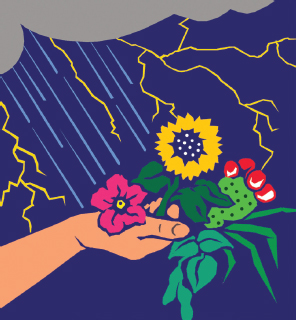
People, farms, and even whole communities may periodically run out of fresh water, but planet Earth does not. Why? Because its living systems use water over and over through endless cycles in such a way that the quality of water—and the life it sustains—is not degraded. Instead it is maintained and even enhanced as it moves through myriad cycles. This increases what is possible, and leads to more life rather than less.
This book challenges you to do the same where you live. Push the limits. Strive to make your site’s beneficial cycles endless, along with their potential. Multiple strategies, tools, and examples are given to help you do this.
This third edition will greatly broaden your site’s array of possibilities by helping you integrate your awareness, harvesting, and cycling of water with other on-site resources such as sun, wind, shade, and community.
This new edition is now in full color, has revised data, revamped many illustrations, added new images, and expanded its tools in appendix 4 enabling you to estimate your plants’ water needs (so all can thrive within your site’s water budget).
All this builds on the second edition’s new and expanded aspects, which included:
• 100-plus pages of new information, over 120 new images, and revision of over 40 illustrations, to provide more than 290 total images enabling you to see in a new way
• Updated case studies of real-life examples including descriptions of their on-going evolution, to help inform your site design (chapters 1 and 5)
• The One-Page Place Assessment, a tool to deepen your awareness of—and connection with—the place you live to help you amplify its regenerative potential (chapter 2)
• Tools for identifying, integrating, and thus maximizing, the harvest and enhancement of multiple free on-site resources, including water (chapter 4 and appendices 5, 7, 8, and 9)
• A completely renovated approach to seeing, understanding, and responding to natural flows of water and sediment, so you can work with, not against, these flows (appendix 1)
• A harvest calendar of my region’s native, wild, and cultivated foods that you can use as a template for your area to help diversify and augment potential harvests there (appendix 4)
• Addition of a Rain Garden Zone column to plant lists telling you the ideal location for each plant within or beside a water-harvesting earthwork (appendix 4)
• Charts illustrating the water-energy-carbon nexus of sample households, and how a heightened awareness of this nexus informs actions that dramatically reduce your—and your community’s—consumption of water and energy, along with emissions of carbon and other contaminants. Better still, this informs actions that can dramatically increase the quality and quantity of nonpolluting, locally-renewable water and power sources (appendix 9)
Harvesting on-site water—primarily rainwater, but also stormwater, greywater (from household drains), and condensate—remains the core of this book. This edition also shows you how to combine water harvesting with harvests of other on-site resources in a way that generates and regenerates whole new resources.
This is all simple, fun, powerful, and often low cost or free. Best of all, we don’t have to do all the work when we and our systems are integrated with— or are in relationship with—our planet’s natural and perpetual conditions and processes. These include the force of gravity and materials moved by it; the sun’s differential heating of the Earth; air and ocean currents that are set in motion by this heating and the spin of the planet; the storms and rainwater these currents bring as the hydrologic cycle recirculates the Earth’s water; the solar-powered photosynthetic plants that grow tall while drinking, filtering, and releasing cooled water through leaves and fruits; the storm clouds regenerating from the cooled moisture—evapotranspired through the plants—which then condenses as raindrops around tiny air-borne particles of organic matter also generated by the vegetation; the sheltering shadows these plants cast; the leaf-drop-eating, fertility-building soil microbes that feed the plants, as the plants’ biomass and sugars feed the microbes; and the faunal life forms—including us—who are sustained by, and in turn have evolved to contribute to, this amazing self-renewing abundance.
Tapping this potential creates and enhances living legacies, which enrich those who are here now and will be cherished by those who inherit them. Everyone benefits in the present and across time.
This compelling vision is what generated this book, fed by years of my on-going hands-on learning, and the copious experience that others have shared with me. In turn, I share this vision, learning, and experience with you to raise the springboard from which we can launch to higher and more dynamic levels of awareness, understanding, caring, ability, action, abundance, and joy.
